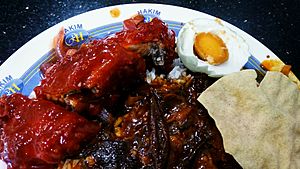Nasi kandar facts for kids

|
|
| Type | Dish |
|---|---|
| Course | Lunch and dinner |
| Place of origin | Malaysia |
| Region or state | Penang |
| Created by | Malaysian Indian |
| Main ingredients | Rice, meat and curry |
Nasi kandar is a super popular meal from northern Malaysia. It first came from a place called Penang. This tasty dish was made famous by Tamil Muslim traders who came from India. It's a meal of steamed rice served with lots of different curries and yummy side dishes.
Contents
What Does "Nasi Kandar" Mean?
The name nasi kandar has a cool story! Long ago, street sellers would carry their rice meals on a special pole. This pole, called a kandar pole, rested on their shoulder. They would balance two big containers of rice and food on it. Nasi means "rice" in Malay. So, "nasi kandar" means "rice carried on a pole." Today, many Indian Muslim restaurants in Malaysia, often called "Mamak" restaurants, use "nasi kandar" in their names.
The History of Nasi Kandar
One of the oldest nasi kandar restaurants in Penang is called Hameediyah. It started way back in 1907! Back then, it was just a small stall under a tree. After many years, nasi kandar even traveled back to India. A restaurant called Pelita Samudera Pertama opened a branch in Chennai. In 2022, the very first nasi kandar restaurant opened in Japan. It was the first special shop there to serve real Malaysian-Indian food.
What's in Nasi Kandar?
The rice for nasi kandar is often kept in a tall wooden container. This container can be about three feet high! It helps give the rice a special smell and taste.
Delicious Side Dishes
Nasi kandar comes with many different side dishes. You can choose from things like fried chicken or curried beef. There's also lamb, fish roe, fried prawns, or fried squid. For vegetables, you might find aubergine (also called brinjal) or okra (lady fingers). Sometimes, there's even bitter gourd.
The Special Curry Mix
One of the best parts of nasi kandar is the curry sauce! A mix of different curry sauces is poured right over your rice. This is called 'banjir,' which means "flooding." This mix of sauces gives the rice a super rich and different taste.
How It's Served
Traditionally, all the food for nasi kandar was served on one plate. Nowadays, some places use small plastic bowls for the side dishes. But don't worry, the special curry sauce mix is always poured directly onto your rice!
In recent years, many nasi kandar restaurants have become big chains. Some popular ones are Nasi Kandar Shaaz and Pelita Nasi Kandar. Some people who love the old ways say these new chain restaurants don't taste exactly like the original ones from Penang. In some parts of northern Malaysia, the rice is even colored yellow using special herbs.
See also
 In Spanish: Nasi kandar para niños
In Spanish: Nasi kandar para niños

